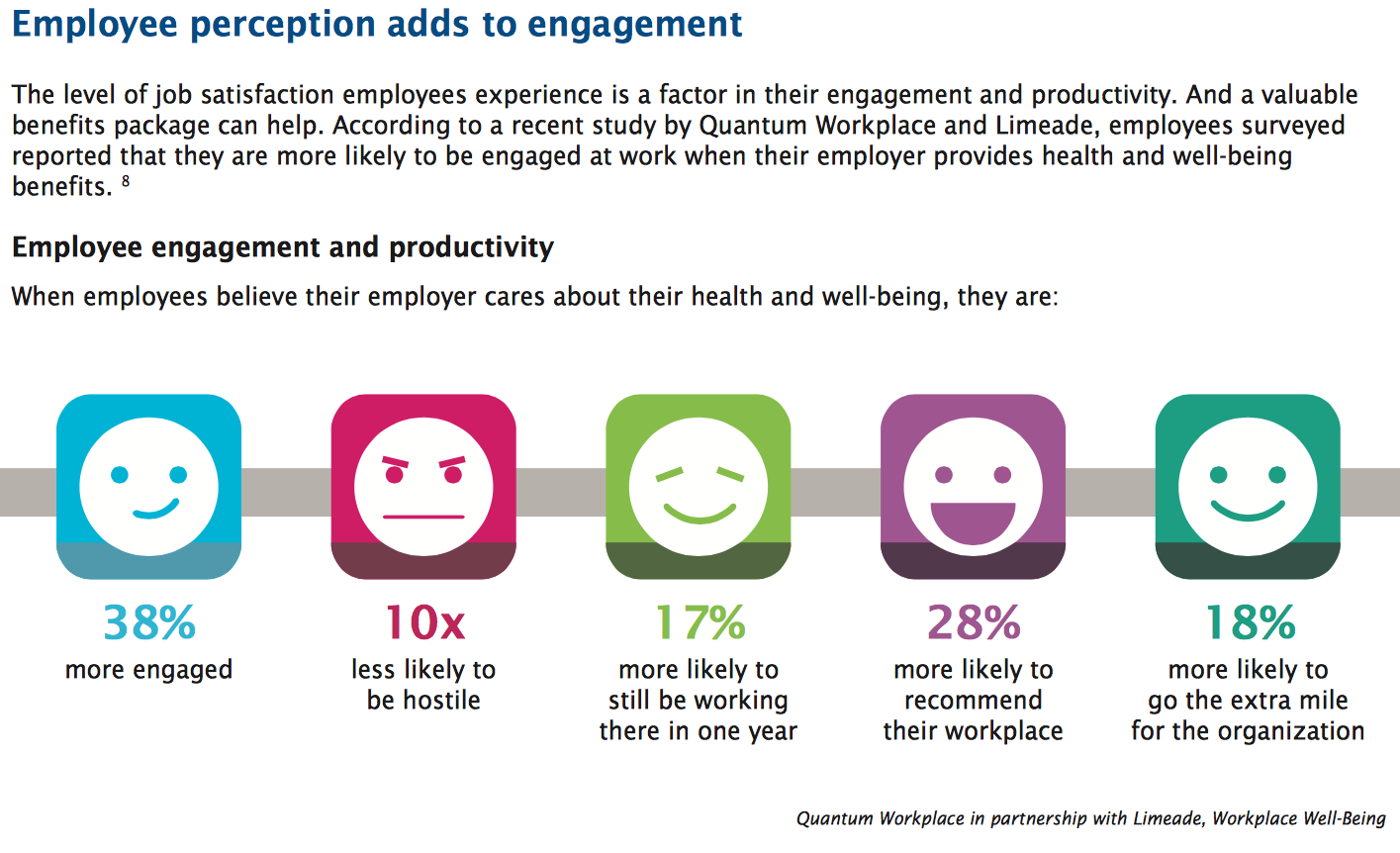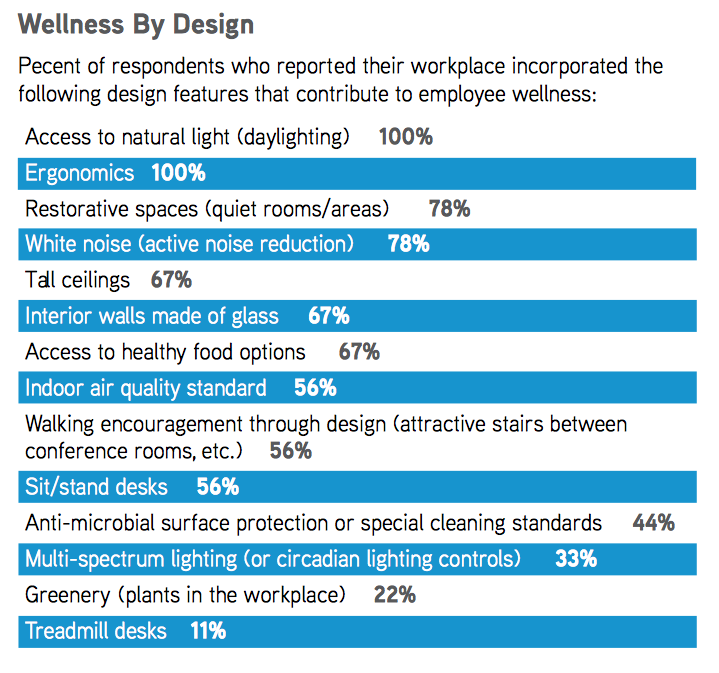Advantages of Workplace Well-Being
When a machine breaks on an assembly line, we spare little expense to fix it because productivity is at stake. Likewise, we do not run machines with known safety hazards due to the fear (and the liability) of employees being injured. However, if we take a step back to examine our employees—after all, their unique knowledge and capabilities are the “machines” that keep us moving forward in the modern workplace—we see a largely unhealthy workforce plagued by stress, obesity, physical inactivity, and a lack of sleep. The declining health of our population has significant consequences at the organizational level, but by taking a proactive approach to employee health through wellness initiatives, companies can improve the health of their employees and the bottom line.*3
A well-executed wellness strategy provides the information, support and motivation employees need to achieve and maintain good health. It also adds to the value of the benefits package and helps demonstrate to employees that their employer cares about their health and well-being. All of these things affect a company’s success in the marketplace.*1
Importance of Leadership Role Modeling
Experts point to a trio of modifiable, lifestyle factors as major contributors to chronic diseases, and consequently, to the staggering financial toll on businesses.
Of all the lifestyle factors, excess stress exacts the biggest toll.
Despite dire statistics, chronic conditions are often preventable and frequently manageable through early detection, diet and exercise – the cornerstones of workplace wellness programs. However, getting employees to participate in programs can be a challenge. The key to maximize participation is customization of programs to an organization’s specific workforce.*4
Employee buy-in is tied to management buy-in. When employees see the CEO on the treadmill next to them or attending a weight management seminar, for instance, they may be more likely to recognize the value and significance of the program.
These “best practices” strategies can help maximize employee participation:
- Include employees in the planning.
- Share success stories.
- Show senior management’s involvement.
- Remind and update employees regularly about all the components and benefits of the program.
- Make it easy to participate in the program and communicate how simple it is to get started.
- Emphasize the value of the program. Promote the fact that a healthier lifestyle results in fewer medical costs and improves quality of life.
- Include spouses and family members in communications efforts.
- Communicate that participation is expected*4
Employee Engagement
Any of the following strategies can be used to help build employee engagement:
- Encourage participation at all levels of the company.
- Design the program to fit your unique needs.
- Make changes and adjustments.
- Appoint a wellness team.
- Communicate the program through multiple methods.
- Improve access to wellness resources.
- Offer valuable incentives.
- Don’t give up.*1
ROI
Workplace wellness programs started quantifying ROI for their initiatives only within the last 25 years. The overwhelming evidence is that offering wellness components in the workplace make a considerable contribution, not only to employee health but to a healthier bottom line of the company.*5
From reducing the cost of healthcare, life and disability insurance to decreasing the number of days employees are absent, wellness programs have been exceeding expectations.
Your ROI will depend on which wellness components you include in your plan. Some programs will involve little or no cost, such as initiating a walking program. More expensive fitness programs, for instance, may include a company-paid membership to a gym. At the far end of the spectrum is providing onsite facilities for stress management-related programs or full-fledged fitness regimens.
The most important contribution to your ROI, however, will be the participation of your employees. And that depends on a well developed business strategy.*4
Wellness programs are more than a perk. A majority of companies regard them as an effective way to address the rising trend of chronic diseases from diabetes to heart disease and the related costs that are draining their bottom line. Eighty percent of these diseases are lifestyle related, experts say, and having a wellness program on-board that helps employees adopt healthier habits can significantly reduce illness, accidents, absences and medical claims. Increased productivity is an additional and hard-to-ignore benefit.*5,6
Companies with wellness programs report Return on Investments (ROIs) of up to 5:1.*5
Healthy employees benefit their employers in two ways: first, they help keep the company competitive in today’s market. Why? Because when employees feel better and have fewer ailments, they are able to be more engaged at work. This can help improve productivity. Second, healthy employees often spend less on healthcare. Since healthcare benefits account for 32 percent of the total cost of employee benefits, it’s extremely important to a company’s budget to improve the health of its employees. *5
As companies incorporate techniques to combat rising healthcare costs, wellness programs stand out as an employer’s best defense—against both direct healthcare costs and indirect costs such as lost productivity and employee absenteeism.*1
Here are four reasons why wellness programs have financial advantages: Lower medical costs, Increased employee morale, Decreased absenteeism and Decreased presenteeism.*2
Health and wellness programming in the workplace may be the single most effective and proactive tool for simultaneously combating increases in health care costs and declines in employee health (DeVries, 2010). The evidence is now clear that wellness interventions can reduce long-term health care costs and employee absenteeism while increasing worker productivity and job satisfaction. Additionally, researchers have found that by providing incentives and the proper tools, sedentary people can become more active, healthier employees. These trends demonstrate that employers can no longer afford to wait on the sidelines, hoping that employee health will improve. Rather, it is becoming a matter of necessity for employers to invest in proper wellness programs that guide employees to healthier lives and spare related bottom line costs.*2
Additional Research
There are many ways to measure the effectiveness of wellness programs, including employee attraction and retention, employee satisfaction and reduced sick days.* 1
In the middle of the rankings fell designs that encourage movement. This is understandable as the idea that movement—any movement—is beneficial to health and mental acuity is just now being supported by data. A 2014 study by Stanford University researchers Marily Oppezzo and Daniel Schwartz (“Give Your Ideas Some Legs: The Positive Effect of Walking on Creative Thinking”) found that when people were enabled and encouraged to walk, even within the office, their levels of creativity rose. Studies have shown that walking also helps improve attention and short-term recall.
All these measured benefits led to feelings of well-being and improved health.*2
*Resources
1. Make Wellness Work for You
Building an effective wellness strategy.
A White Paper by Meritain Health
(https://www.meritain.com/Media/Default/White%20Papers/White%20Paper%20-%20Wellness.pdf)
2. EMPLOYEE WELLNESS
How Does Your Workplace Make You Feel?
Colliers International
(http://www.colliers.com/-/media/files/marketresearch/unitedstates/2015-market-reports/colliers-employee-wellness)
3. The Business Case for Employee Health and Wellness Programs
Mary Margaret Harris, Ph.D. Levi Strauss & Co.
(http://www.siop.org/WhitePapers/casehealth.pdf)
4. Guide to Workplace Wellness by Health Advocate:(http://healthadvocate.com/downloads/whitepapers/WorkplaceWellnessGuide.pdf)
5. U. S. Department of Health and Human www.cdc.gov/chronicdisease/resources/
6. Partnership to Fight Chronic Disease, “Chronic Disease Risk Factors & Causes,” www.fightchronicdisease.org



